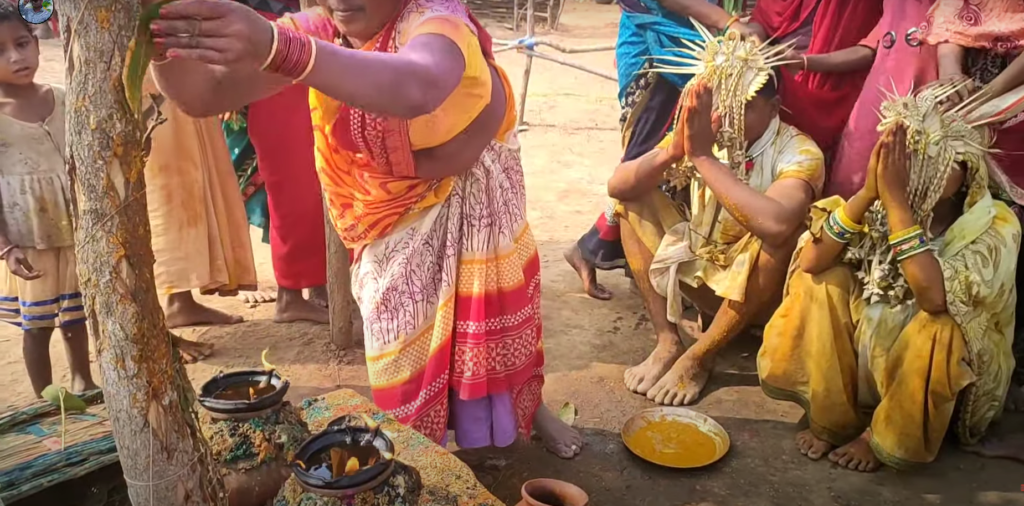Gond or Gondi is the Indian tribe that welcomes tourists with fruits and small gifts. They are known as the largest tribes in South Asia. Gondi people reside in Madhya Pradesh, Maharashtra, Chhattisgarh, Uttar Pradesh, Telangana, Andhra Pradesh, Bihar, and Odisha. You can notice their love for their cultural heritage in every little corner of their village.

On their house walls, you will see black and white painting designs. They have a rich tradition of tribal arts that includes floor painting, basket weaving, pottery, and body tattooing. They speak Gondi that belongs to the family of Dravidian language. However, since they are scattered over different states, they are also fluent in the language dominant in their state, such as Marathi for Maharashtra or Hindi in the Hindi-speaking states.
Let’s learn more about their fascinating history.
Origin Story of Gond Tribe
Scholars believe that the Gond tribe traces back to the 13th century when they ruled the Gondwana Kingdom. Gondwana is now known as Eastern Madhya Pradesh. Their reign lasted till the end of the 16th century. The flourishing Maratha empire swept off the Gondwana Rajas and replaced them. Before being defeated Gondwana Rajas built various forts, temples, tanks, and lakes for the benefit of their kingdom. You can still find the ruins of these beautiful structures in present-day Madhya Pradesh. For instance, Satkhada in Mandala is an exceptional sight to visit. The fort protected the Kingdom from enemy attacks. It has one tower and temple built therein.
The list of Gond leaders is a long and inspiring one. Jadurai is known as the first Gond King who deposed the Kalchuri Rajputs to take over the throne of Garha Mandala. One of the most famous Gond rulers is the strong and mighty queen Rani Dugravati. She fulfilled her duties as a ruler after the demise of her husband and protected her subjects from the claws of the Mughal emperor, Akbar.
Those were the glorious days for the Gondi people. Nowadays, the Gondi tribe depends heavily on agriculture.
Art and Culture
Gond tribe is best known for its colorful and cheerful traditions. You can see the beautiful art on their house walls and the woven baskets on their shelves. Gond paintings focus on natural elements and their God. They use dots and lines to show the beauty and power of nature in the forms of animals, plants, forests, and deities. Gondi people like to celebrate their festivals with dance and music. A big part of Gond culture is Dandari Dance. In this dance, they narrate the mythological stories of Gond. People dance in circles and help the audiences understand the significance of Gond mythology.
Gond tribe believes in the division of caste based on the art they follow. The professional musician caste is known as Dhulia, and they play the soulful music of Gonds to bring life to every festival celebration in the villages. What makes the Gond tribe unique is that they not only have a professional musician caste but they are also skillful in making instruments.
Apart from dance and music, the Gond tribe also specializes in folklore. This means that there are numerous legends, myths, and stories in the Gond tribe that has been handed down from generation to generation through the oral medium. These legends and stories are narrated by the Pradhans (bards) only. Let’s learn some of the most important legends believed by the Gond tribe and narrated by the Pradhans.
Gond Gods
In one of the most famous Gond legends, it is said that when the Gond gods were born their mother abandoned them. It was the Goddess Parvati who later rescued them to save their lives. However, things didn’t go according to plan. Lord Shiva captured the gods in a cave. No one could ever rescue them from Lord Shiva. But one day the Gond hero, Pahandi Kapar Lingal succeeded in this mission and rescued all the Gond Gods with the help of Goddess Jangu Bai. Now, when the Gods came out they were divided into four groups which led to the four divisions of the Gond Tribe- Raj Gonds, Madia Gonds, Dhurve Gonds, and Khatulwar Gonds. This legend holds an important place in the Gond beliefs and their worshipping.
Great Gods and Clan Gods
Gond has a hierarchical system of worshipping. They suppose that Badadeo is at the higher position of the hierarchy, so they worship him as the great god. However, their true devotion is towards their clan or village god which is assigned to protect their village. Other names for Badadeo are Bhagavan, Sri Shambu Mahadeo, and Persa Pen. He looks after the lesser gods or the clan deities.
Gond tribe celebrates various holidays including Dussera, Pola, and Nagpanchami. Some believe that rituals in Hinduism and Gond culture are similar but if you look intricately, they have significant differences. Gond is also known as Koiture. It is a pure tribe that has struggled to retain its traditions over centuries. If you are planning to visit India, put a Gond village on your list.
